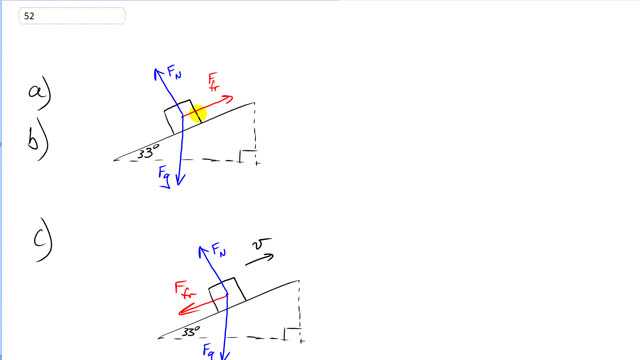
- A box sits at rest on a rough inclined plane. Draw the free-body diagram, showing all the forces acting on the box.
- How would the diagram change if the box were sliding down the plane?
- How would it change if the box were sliding up the plane after an initial shove?

In order to watch this solution you need to have a subscription.
This is Giancoli Answers with Mr. Dychko. For parts A and B, the free body diagram of this block on a ramp is almost identical, it'll have the same three arrows, but in part B when it's sliding down the ramp, this friction force is kinetic friction whereas in part A when it's at rest on the ramp, this friction force is a static friction force. But otherwise it's the same three arrows. You have a friction force pointing up the ramp that keeps it from sliding down or at least reduces the rate at which it slides down for part B. And you have gravity straight down. And then you have a normal force perpendicular to the surface of the ramp. For part C, the difference is that with the block sliding up the ramp after initial shove, it's gonna have some velocity that direction. And the friction force will be kinetic friction going in the opposite direction to the velocity so, the friction force will be pointing down the ramp in this case. And otherwise the gravity and the normal force are the same.
Hello!
I am still confused as to why the diagrams for a) and b) are the same. I don't understand how in a) the box has static friction, but b) has kinetic friction and their diagrams are the same. Shouldn't b) have a velocity vector pointing downward?
Thank you so much for your time!
Hi schamorg, thanks for asking this question. Understanding free body diagrams is really important, so it's good your digging into the topic. A free body diagram does not include a velocity vector. I sketched one in for part "c", but that was just to emphasize which direction the box is moving in order to explain why the force arrows are pointing the way they are. Notice that the velocity vector does not begin on the center of the box, since I didn't want to make is seem like another force vector. Force vectors are always written with their beginning a the center of mass of the object (usually the geometric center... just ignore this point if it's confusing). Technically, velocity vectors do not belong on free body diagrams. OK, so to answer your question, for parts "a" and "b" there is intentionally no velocity vector at all since free body diagrams only show force vectors. In both parts "a" and "b", the friction force is directed up the ramp, and so the arrow representing these frictions forces point in the same direction. I suppose there is a case for making separate diagrams, but the distinction is only this: the kinetic force vector of part "b" should be shorter than the static friction force vector of part "a" since kinetic friction is always weaker than static friction.
Hope this helps,
Mr. Dychko
Thank you so much. This was very helpful actually.
Super! I'm glad, and thanks for the feedback. :)